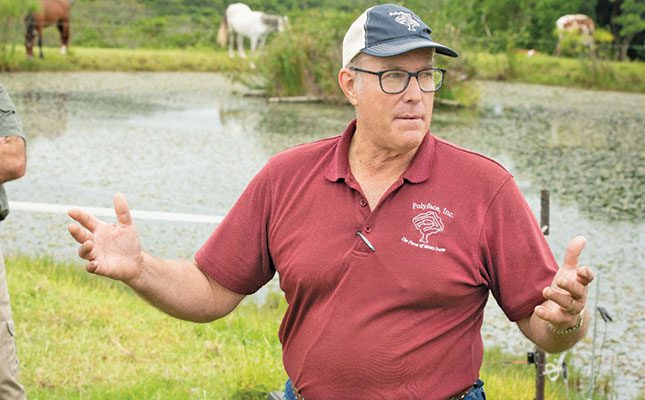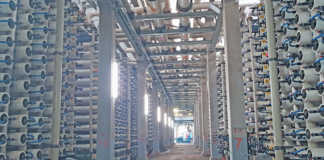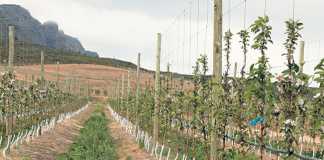
Photo: Supplied
What are your thoughts on South Africa’s agriculture sector? What impressed you and what was worrying?
South Africa is like every other place in the world: it has assets and liabilities. A perfect agricultural environment doesn’t exist anywhere on the planet, so you have to leverage your resources and mitigate your deficiencies.
Flying from Cape Town to East London, I was struck by the brown fields: no different from the grain-growing regions of the US. These fields need cover crops desperately to keep a covering on the soil. Nothing destroys soil faster than being naked.
The few cattle I’ve seen have been left to graze continuously rather than being mob-stocked. This also gradually depletes the vegetation, turning good plants into poor plants. It reduces overall biomass production.
I’m impressed with your water and warmth. Much of our precipitation in Virginia comes in the form of snow and we get intense freezing. To have such a long growing season and be able to pipe water easily is a true blessing.
Why should farmers use more environmentally-friendly farming practices?
For all their political and fractious stories, civilisations rise and fall primarily because of ecology. They rise during abundance and collapse during scarcity. Agriculture, from the beginning of human history, doesn’t have a good ecological track record and generally exhibits practices and attitudes dedicated to exploitation rather than nurturing.
If any nation wants to preserve itself, it must realise that ultimate wealth is not in banks or entertainment; it’s in the soil. No nation can be wealthier than its soil. No nation can be healthier than its soil. If we don’t first figure out how to build soil, to make happy earthworms, powered by photosynthesis rather than petroleum in chemicals, we won’t enjoy societal abundance and longevity. It’s that simple.
Have you found that you need to let profits decline in order to promote sustainability?
Plenty of farms go bankrupt using unsustainable, orthodox agri-industrial principles.
By the same token, using alternative methods doesn’t guarantee profitability. Both kinds of farms can suffer economic problems. With that said, the short answer is that profit and production have nothing to do with each other.
Only three ways exist to increase profit: decrease expenses, increase prices, or increase turnover, assuming you have a positive margin.
Our farm is certainly as profitable as most (or more so), due to numerous strategic methods, not all of which are tied to being ecologically based. For example, we purchase massive amounts of GMO [genetically modified organism]-free grain from local farmers.
Since we pay extra for it, at first blush this may seem anti-profitable. However, it creates differentiation in the marketplace that lets us tell an authentic and consistent story, which resonates with our health-minded customers. Here are some things we do that may help folks understand our financial unorthodoxy:
- Eggmobiles
Like the oxpecker on the rhino […], we follow the cattle with portable chicken trailers so
that the chickens can scratch through the cattle dung, feeding on the fly larvae, and spread [the dung] across the pasture. It’s a biological pasture sanitiser, eliminating the need for herbicides and parasiticides, and providing thousands of dollars’ worth of eggs as a by-product. - Pig aerating
When we feed hay in winter, we do so under awnings and use wood chips as a carbonaceous diaper to lock in and tie down those volatile and soluble nutrients coming out the back end of the cow (20kg per day). As the bedding builds, we add [maize], which ferments in the anaerobic pack. When the grass grows again and we turn the cows out to graze, we put in pigs, which seek the embedded fermented [maize] and aerate the pack, converting it to aerobic compost. Rather than using expensive machinery to turn compost, we use pigs, which appreciate it, don’t need diesel, and
drive themselves. This is the crux of our fertility programme. - Chipping
Instead of buying chemical fertiliser, we purchased an industrial wood chipper that can create 1m³ of woodchips every two to three minutes. It can handle material with a diameter of 450mm. We [remove] dead, crooked, undesirable material from the woodlot to become the carbon base for the carbonaceous diaper mentioned above. This upgrades the woodlot and offers a true carbon economy to the farm and soil. - Moving, mobbing and mowing
Mimicking nature’s herbivorous migratory patterns, we use high-tech electric fences to duplicate the landscape choreography of herds. Our county average is 80 cow days per acre [0,4ha] from pasture production and we average 400 cow days per acre [80 cow days per acre means that a farmer can keep one cow on one acre for 80 days or run 80 cows on one acre for one day]. This is accomplished not with inputs, but with management. We lease 15 properties in the area and we’ve never taken over a new place without doubling its production in the first year after an initial capital cost of about US$120/ ha [about R2 070/ha] for fencing and a water line. - Mobile, modular and management-intensive
Nearly all of our infrastructure is mobile, which means that we can separate the farming from its biggest expense: land cost. If your infrastructure is mobile, you can place your farm anywhere. This achieves scale not by centralisation, but by duplicating through adding modules. This again reduces initial capital cost and allows a way in for young or uncapitalised want-to-be farmers. By requiring management intensity, our systems move farm equity away from things and towards people. No bank can foreclose on your knowledge or repossess your skill. Your equity is in knowledge, skill and customers, rather than energy intensity, capital intensity, pharmaceutical intensity and depreciation intensity.
Where should a new farmer start if he or she wants to farm in an environmentally-friendly manner?
Start where you are with what you can. Too many people think they need to own land, or they need to be someplace else. You can start with a vermicomposting kit under your kitchen sink, a hanging herb garden on your patio, or a 1ℓ jar sprouting mung beans on the windowsill.
Get comfortable and get confident.
Lots of partnerships are developing; you can stack an enterprise on an existing piece of land. Let the opportunities develop as you prove faithfulness and excellence where you are with what you’ve got.
Where should established commercial farmers start if they want to move to a more environmentally friendly farming practice?
If you’re a commercial farmer wanting to transition, you need to experiment in ways that won’t sink your ship. Do some trials; play with some prototypes. You need incremental confidence. Don’t jump off the cliff.
That being said, getting close to people already doing what you want to do is invaluable. Spend time with them and attend seminars. Invest in where you want to go. Mentorship is still the most efficient way to learn mastery.
South Africa’s water is quite polluted due to a lack of maintenance of water infrastructure. Is it possible to farm in an environmentally friendly manner, even if your infrastructure isn’t that of a developed country?
Environmental toxicity, whether it’s water or chemical residue, exists virtually everywhere on the planet. You can’t change it. Don’t get bogged down worrying about what you can’t change. Organic matter eats toxicity; build it into your soil with carbon decomposition.
Organic matter is like a buffer against everything that’s bad. Build ponds and line them with plants that suck up impurities. Deliver water to your livestock in a plastic pipe so the animals don’t soil creeks and ponds. You can’t control the raindrops that fall on your land, but you can control the organic matter that builds in your soil. Focus on what you can do where you are and you’ll never run out of positive, innovative things to do. It’ll make you excited to wake up every day for the rest of your life.
Email the Permaculture Institute for Southern Africa at [email protected].











